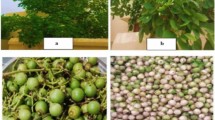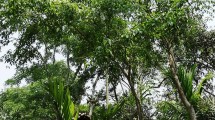Abstract
It has been reported that plants that experience some form of stress while growing tend to accumulate increased levels of nutrients that are useful to humans. We compare the proximate and mineral composition of Tamarindus indica leaves, fruit pulp and seeds from Uganda’s semi-arid and sub-humid zones with contrasting environmental conditions including temperature, rainfall, soils and geology. Samples were analyzed following standard AOAC procedures. Mineral content was in the order K > Ca > Mg > Na > Fe and K > Mg > Ca > Na > Fe for the semi-arid and subhumid zones respectively. Tamarindus indica fruit pulp and leaves from both zones plus seeds from the semi-arid zone contained the Na/K ratio of < 1 recommended by World Health Organisation for prevention and treatment of cardiovascular diseases. Proximate composition for leaves, fruit pulp and whole seeds were in the following ranges: Moisture content (9.83–69.42%), ash (1.93–11.6%), carbohydrate (64.74–88.7%), crude lipid (0.96–3.57%), crude fiber (0.89–14.93%), and crude protein (4.59–14.82%). Leaves contained higher levels of crude protein, crude lipid and crude fibre than fruit pulp. Tamarindus indica from the semi-arid zone tends to accumulate nutrients in ways that better promote human health. Tamarindus indica from both zones has high potential to provide functional foods and livestock feeds.


Similar content being viewed by others
References
Z. Bharucha, J. Pretty, The roles and values of wild foods in agricultural systems. Phil. Trans. R. Soc. B 365(1554), 2913–2926 (2010). https://doi.org/10.1098/rstb.2010.0123
FAO, IFAD, UNICEF, WFP, WHO, The state of food security and nutrition in the world 2017. Building resilience for peace and food security (FAO, Rome, 2017)
FAO, IFAD, WFP, The state of food insecurity in the world 2015. Meeting the 2015 international hunger targets: taking stock of uneven progress (FAO, Rome, 2015)
HarvestChoice, Agro-ecological Zones of sub-Saharan Africa (International Food Policy Research Institute and University of Minnesota, Washington, DC, St. Paul, MN, 2010)
FAO, Agro-ecological zoning. Guidelines. FAO Soils Bulletin 73 (FAO, Rome, 1996)
K. El-Siddig, H.P.M. Gunasena, B.A. Prasad, D.K.N.G. Pushpakumara, K.V.R. Ramana, P. Vijayanand, J.T. Williams, Tamarind (Tamarindus indica L.). Fruits for the future 1—revised (International Centre for Underutilised Crops, Southampton, 2006)
Katende AB, Birnie A, Tengnas B, Useful trees and shrubs for Uganda. Identification, Propagation and Management for Agricultural and Pastoral Communities. Technical book No. 10. Regional Soil Conservation Unit (RSCU) (1995), pp. 710
E. Ebifa-Othieno, A. Mugisha, P. Nyeko, J.D. Kabasa, Knowledge, attitudes and practices in tamarind (Tamarindus indica L) use and conservation in eastern Uganda. J. Ethnobiol. Ethnomed. 13, 5 (2017). https://doi.org/10.1186/s13002-016-0133-8
F.A. Khairunnuur, A. Zulkhairi, A. Azrina, M.A.M. Moklas, S. Khairullizam, M.S. Zamree, M.A. Shahidan, Nutritional composition, in vitro antioxidant activity and Artemia salina L. lethality of pulp and seeds of Tamarindus indica L. extracts. Malays. J. Nutr. 15(1), 65–75 (2009)
A.A. Yusuf, B.M. Mofio, A.B. Ahmed, Proximate and mineral composition of Tamarindus indica Linn 1753 seeds. Sci. World J. (2007). https://doi.org/10.4314/swj.v2i1.51699
E. De Caluwé, K. Halamová, P. Van Damme, Tamarindus indica L.—a review of traditional uses, phytochemistry and pharmacology. Afr. Focus 23(1), 53–83 (2010)
H.P.M. Gunasena, A. Hughes, Tamarind (International Centre for Underutilised Crops, Southampton, 2000)
Kader AA. Influence of preharvest and postharvest environment on nutritional composition of fruits and vegetables, in Horticulture and Human Health: Contributions of Fruits and Vegetables, ed. by B. Quebedeaux, F.A. Bliss. Proceedings of the 1st International Symposium on Horticulture and Human Health, Prentice-Hall, Englewood Cliffs, NJ pp. 18–32 (1988)
Bear FE, Toth SJ, Prince AL, Variation in mineral composition of vegetables. Soil Sci. Soc. Am. 55(5) (1991), http://www.soilandhealth.org/06clipfile/RCE/rceALL.html. Accessed 9 Jan 2013
FAO Soils Bulletin 17 (undated). Trace elements in soils and agriculture (FAO, Rome)
K. Crosby, J. Jifon, D. Leskovar, Agronomy and the nutritional quality of vegetables, in Improving the Health-Promoting Properties of Fruit and Vegetable Products, ed. by F.A. Tomás-Barberán, M.I. Gil (Woodhead Publishing Series in Food Science, Technology and Nutrition, Cambridge UK, 2008)
Famine Early Warning Systems Network (FEWSNET). A climate trend analysis of Uganda. Famine early warning systems network—informing climate change adaptation series. U.S. Department of the Interior and U.S. Geological Survey. Fact Sheet 2012–3062 (2012)
J. Okello, Morphological and nutritional characteristics of Tamarindus indica L. fruits in Uganda. MSc Dissertation, Makerere University, 2010
National Environment Management Authority (NEMA), TORORO District State of Environment Report. NEMA, 1997
Uganda districts information handbook. Expanded edition 2011–2012. Fountain Publishers, Kampala
Association of Official Analytical Chemists (AOAC). Official methods of analysis. 16th ed. (AOAC, Arlington, Virginia, USA, 1995)
WHO, FAO, Vitamin and mineral requirements in human nutrition. Second Edition: report of a joint FAO/WHO expert consultation. (FAO/WHO, Bangkok, Thailand, 2004). 21–30 Sept 1998
N.C. Brady, The nature and properties of soils, 10th edn. (Macmillan Publishing Co., Inc., New York, 1990)
Chiteva R, Kituyi JL, Nutritional value of T. indica, in Forestry Research in Environmental Conservation, Improved Livelihoods and Economic Development. Proceedings of the 3rd KEFRI Scientific Conference, Nairobi (2006)
B. Stenberg, R.A.V. Rossel, A.M. Mouazen, J. Wetterlind, Visible and near infrared spectroscopy in soil science, in Advances in Agronomy, vol. 107, ed. by D.L. Sparks (Academic Press, Burlington, 2010), pp. 163–215. https://doi.org/10.1016/S0065-2113(10)07005-7
D.A. Zebire, T. Ayele, M. Ayana, Characterizing soils and the enduring nature of land uses around the Lake Chamo Basin in South-West Ethiopia. J. Ecol. Environ. 43, 15 (2019). https://doi.org/10.1186/s41610-019-0104-9
Y. Erturk, S. Ercisli, M. Sengul, Z. Eser, A. Haznedar, M. Turan, Seasonal variation of total phenolic, antioxidant activity and minerals in fresh tea shoots (Camellia sinensis var. sinensis). Pak. J. Pharm. Sci. 23(1), 69–74 (2010)
WHO, Guideline: potassium intake for adults and children (WHO, Geneva, 2012)
WHO, Guideline: Sodium Intake for Adults and Children (WHO, Geneva, 2012a), http://www.who.int/nutrition/publications/guidelines/sodium_intake_printversion.pdf. Accessed 7 Feb 2013
J.I. Schwartz, D. Guwatudde, R. Nugent, K.C. Mondo, Looking at non-communicable diseases in Uganda through a local lens: an analysis using locally derived data. Glob Health (2014). https://doi.org/10.1186/s12992-014-0077-5
R. Ben-Shahar, D.W. Macdonald, The role of soil factors and leaf protein in the utilization of mopane plants by elephants in northern Botswana. BMC Ecol. 2, 3 (2002). https://doi.org/10.1186/1472-6785-2-3
J.B.L. Okullo, F. Omujal, J.G. Agea, P.C. Vuzi, A. Namutebi, J.B.A. Okello, S.A. Nyanzi, Proximate and mineral composition of Shea (Vitellaria paradoxa C.F. Gaertn) fruit pulp in Uganda. Afr. J. Food Agric. Nutr. Dev. 10(11), 4430–4443 (2010)
WHO, Global strategy on diet, physical activity and health. Promoting fruit and vegetable consumption around the world. Information sheet (2012c)
NAP, Dietary reference intakes for energy, carbohydrate, fiber, fat, fatty acids, cholesterol, protein, and amino acids (2005), http://www.nal.usda.gov/fnic/DRI/DRI_Energy/energy_full_report.pdf
N.P. Qafoku, Climate-change effects on soils: accelerated weathering, soil carbon, and elemental cycling, in Advances in Agronomy, vol. 131, ed. by D.L. Sparks (Elsevier, Amsterdam, 2015), pp. 111–161
M.V. Flyman, A.J. Afolayan, The suitability of wild vegetables for alleviating human dietary deficiencies. S. Afr. J. Bot. 72, 492–497 (2006)
Acknowledgements
The authors are grateful to Regional Initiative in Science and Education- African Natural Products Research Network (RISE AFNNET) of the Carnegie Corporation of New York and Kyambogo University for financial and logistical support.
Author information
Authors and Affiliations
Contributions
EEO designed the study, collected and analyzed data and coordinated the write up. DJK designed the study with EEO. PN and DN participated in write up. AM participated in data analysis and write up. All authors read and approved the manuscript.
Corresponding author
Ethics declarations
Conflict of interest
The authors declare that they have no competing interests.
Additional information
Publisher's Note
Springer Nature remains neutral with regard to jurisdictional claims in published maps and institutional affiliations.
Rights and permissions
About this article
Cite this article
Ebifa-Othieno, E., Kabasa, J.D., Nyeko, P. et al. Nutritional potential of tamarind (Tamarindus indica L.) from semi-arid and subhumid zones of Uganda. Food Measure 14, 1125–1134 (2020). https://doi.org/10.1007/s11694-019-00362-7
Received:
Accepted:
Published:
Issue Date:
DOI: https://doi.org/10.1007/s11694-019-00362-7




